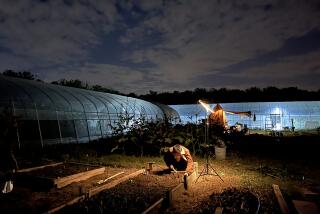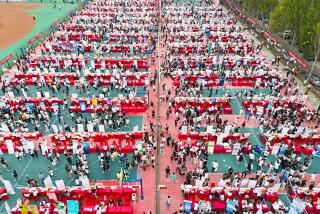A Bumper Crop of Self-Esteem in China
LINGNAN VILLAGE, China â Shi Meirong has time for only two meals a day at the moment. Harvest season has hit her dusty little farm here at the foot of the Taihang Mountains and her irrigated orchards are dripping fruit.
So Shi and her daughter-in-law rise each morning with the sun and scoot out to the market with their produce before 5 a.m. Breakfast, a simple, midmorning affair, doubles as lunch, after which the two women pick peaches, plums and apples for the next four to five hours. On a good day, they fill eight big baskets with up to 600 pounds of fruit.
In the evenings, thereâs dinner--but also Shiâs two pigs to look after. Plus her flock of chickens. And a hutch of rabbits, valuable for their fur. In fact, about the only important domesticated animals missing from her household menagerie, it seems, are men--and she gets by just fine without them.
âMy daughter-in-law and I are in charge of the farm,â says Shi, 52, whose husband and two sons all live and work, or study, in neighboring towns. âItâs not easy--you get very tired,â she admits, but then adds with a chuckle: âNo pain, no gain.â
As head of her household here in the northern province of Hebei, Shi is in the vanguard of an unexpected revolution that has begun to sweep through the vast Chinese countryside, transforming the face of domestic agriculture. Rural women, once regarded as practically useless except to bear children, are fast becoming the anchors of agrarian life, taking over from men who have moved into industry or gone off to seek jobs in Chinaâs burgeoning cities.
Millions of wives now run their family farms. In villages from Liaoning province in the north to Guangdong province in the south, female laborers dominate the fields, easily outnumbering their male counterparts.
A U.N. report estimates that women now produce 50% to 60% of Chinaâs total agricultural output--a proportion likely to increase in the future. By contrast, 13% of farm work in China was performed by women in the 1930s.
The gender reversal in agriculture has triggered one of the most significant social changes in modern China: a growing class of more independent rural women, inspired to assert themselves and take charge of their lives in ways their mothers never dared imagine. More than 400 million women and girls--1 1/2 times the entire U.S. population--live in Chinaâs vast countryside, the largest rural female contingent of any nation.
Many of them, like Shi, now determine what crops to plant, what equipment to buy, what fertilizer to use on their small plots of land--all without bothering to consult their absent mates. Others cook up innovative ways to make money, like the woman in Dongsheng township, outside Beijing, who parlayed crop variety and marketing savvy into a tidy sum larger than her husbandâs income as an urban laborer.
âMy husband doesnât careâ what I do, declares Shi, a genial woman with salt-and-pepper hair and a ready hospitality. âMy daughter-in-law and I make the decisions.â
No More Acceding Silently to Men
For these pioneers, the days are over when they resigned themselves to behaving meekly and acceding silently to the desires and demands of their menfolk.
âThey are not so shy any longer and have more confidence in expressing themselves,â says Marlen Arkesteijn of the U.N. Food and Agriculture Organization in Beijing, which sponsors educational programs for rural women. âTheir self-esteem has really increased. They realize how important their work is.â
But not everyone has benefited. For many rural women--perhaps the great majority--the shift has meant only a heavier workload, without enhanced status in society or even their own households. Mothers-in-law overrule them. Husbands, though miles away, dictate from afar.
Even the most capable of female farmers often cannot secure small loans to finance enterprising ideas, victims of pervasive sex discrimination. Just as crippling is lack of education: One in three rural women is illiterate, unable to read the instructions on a pesticide label or sign her childâs homework assignments.
Still, experts agree that momentous change in the makeup of agricultural labor is taking shape in the worldâs most populous country, following the example of places like Africa, where women have been in the ascendancy on the farm for years. âThe dominance of women in agricultural work across much of rural China . . . represents a radical shift in work patterns,â Australian scholar Tamara Jacka writes in her new book, âWomenâs Work in Rural China.â
The âfeminization of agriculture,â as social scientists call it, began in the late 1970s and early â80s as the nation opened up to market reforms. Women had already assumed more active roles on Chinaâs farms during the collectivist era of Mao Tse-tung. But newly liberalized production and price controls, stronger property rights for women and steady migration of men to the cities in search of higher-paying jobs accelerated the trend.
Now, Chinaâs urban areas bulge with an estimated 100 million migrant workers from the countryside, mostly young males. That has left rural women--once considered so decorative that their feet were bound, turning them into helpless ornaments--to take over the land.
âFrom breeding to harvesting, most women must do it all themselves,â says Zhang Jufang, an editor with âRural Women Knowing All,â Chinaâs only magazine targeted at women outside the city.
The publication provides a window on how far rural women have come in the past two decades--and how far they still must go to rise above the suppression of centuries.
In its four years, the monthly magazineâs subscription base has rocketed from 18,000 to 230,000, an increase fueled by rural women mostly between the ages of 16 and 45, hungry for information relevant to their lives and their growing concerns as they assume duties previously left to men. A staff of one--the magazineâs founder--has multiplied into a payroll of 10 employees, who moved last month into more spacious offices near downtown Beijing to keep up with their productâs unexpected success.
Albeit a slim, almost pocket-sized pamphlet, without snazzy graphics or glossy covers, each issue comes stuffed with two dozen or so articles on an array of topics, from the technological to the psychological. âWe not only teach [women] how to get rid of poverty, but how to be a full person,â explains Xie Lihua, the magazineâs founder and editor in chief.
In the May issue, fashion tips (âShowing That Peasant Girl Styleâ), inspirational stories (âHow I Became the Bossâ) and advice for the lovelorn (âSuffocating Love Bears Bitter Fruitâ) mingled with practical news on crops (âA New Kind of Mushroom: Fengqing No. 518â) and parenting (âGive Your Child an Education in Lifeâ). Popular columns offer legal counsel for female farmers and updates on agricultural policy--areas thought to be beyond the ken of women not long ago.
Hundreds of letters pour into the magazineâs mailbox every month, helpful missives from women with hints to pass along or helpless pleas for solutions to personal and vocational problems. Xie insists that each query receive a response.
âIf we want Chinese women or the womenâs movement to progress, we must focus on rural women,â says Xie, whose work has won international awards. âThe purpose of this magazine is to show women that there is no difference between them and men. First and foremost, youâre a human being. Secondly, youâre a woman.â
But Chinese women have been saddled with darker problems from the past that have not been so easily discarded, the legacy of centuries of confinement to spheres of little influence and few opportunities. Even urban women, who now enjoy greater education and job possibilities and more freedom of movement than their rural counterparts, have not completely shaken off their historical status as second-class citizens or the burdens of male-dominated society.
Lessons Drawn From Womenâs Suicides
A more ominous monthly feature in âRural Women Knowing Allâ is titled âWhy They Commit Suicideâ and deals with a phenomenon with roots deep in Chinaâs history--downtrodden rural women who view killing themselves as the only way to escape loneliness, shame, misery or oppression.
Suicide--usually by swallowing insecticide--remains a major problem among rural women. The column recounts a new case every month, draws lessons from what impelled the woman to take such a drastic measure and suggests how others might avoid the same fate. To Xie, the key is boosting the self-esteem of her readers, who have few markers against which to measure their lives.
Xie says: âI tell them, âYouâre already accomplished. Youâre better than those women in the cities. You need to have self-confidence.â â
Government and nonprofit agencies teach women technical skills on the farm. About 70% of all participants in the Food and Agriculture Organizationâs on-the-spot training sessions in Chinaâs northwest region are women, says program officer Arkesteijn. Other groups show women how to make handicrafts to supplement their incomes in the off-season.
During the harvest in Lingnan Village, where 80% of the farms are headed by women, Shi gets so tired at night that she doesnât even have the energy to watch television in her sparsely furnished bedroom. Chinese rural women--who toil in the house cooking meals and washing clothes, as well as in the fields--work 11 hours a day on average, an hour more than men, a U.N. study found two years ago.
But when peak season passes, Shi and her neighbors bend their weather-beaten hands to weaving small trinkets out of straw, peddled at a market 12 miles away, says Wang Shuhua, who runs her familyâs farm while her husband, a carpenter, bounces from project to project.
His work sometimes keeps him away from home for months at a time. Shi sees her husband, a bureaucrat in another town, just once every two weeks. Such separations have taken their toll on rural marriages; divorce, though extremely low by Western standards, is increasing.
The trade-off is the extra money generated by the men; the sums may not swell bank accounts but at least pay for the menâs own keep. As more and more rural women take on greater responsibilities, their share of household income has steadily risen, from 20% in 1950 to 40% in 1995. In some âspecialized households,â where farmers have abandoned major crops to sell niche items like greenhouse vegetables or eggs, women rake in up to 70% of the family revenue.
âIt has given them, to a great extent, a feeling that theyâre playing a major role in their households,â says Farhana Haque Rahman, a program analyst with the International Fund for Agricultural Development in Rome.
Rural Change Brings More Independence
While more social gains must be made, she says, including a greater push for political participation by women, the gender revolution in Chinese agriculture âhas brought women more independence.â
It is a measure of freedom and responsibility that Shi did not foresee as a girl growing up on her parentsâ farm not far from her current home. âI didnât imagine I would be running my own farm,â she says.
Nor did she think she would blaze a trail virtually the entire village has followed. Fifteen years ago, after visiting relatives who were doing well selling fruit, she became the first person in Lingnan Village to switch from growing corn and wheat to planting peach trees, although it seemed risky to depart from the norm. âI said, âI donât care what the others are doing--the profit looks a lot better,â â she says.
Having seen her succeed, almost everyone has since followed her lead. Now, Shi is thinking of moving on to persimmons. âWhatever makes a profit, Iâll plant.â
More to Read
Sign up for Essential California
The most important California stories and recommendations in your inbox every morning.
You may occasionally receive promotional content from the Los Angeles Times.











